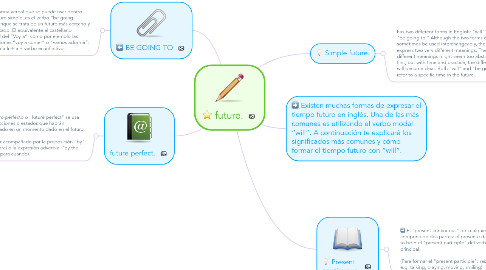future.
by elyseth marin

1. Simple future.
1.1. has two different forms in English: "will" and "be going to." Although the two forms can sometimes be used interchangeably, they often express two very different meanings. These different meanings might seem too abstract at first, but with time and practice, the differences will become clear. Both "will" and "be going to" refer to a specific time in the future..
2. Present continuous.
2.1. El "present continuous" de cualquier verbo se compone de dos partes: el presente del verbo to be + el "present participle" del verbo principal. (Para formar el "present participle": raíz+ing, e.g. talking, playing, moving, smiling)
3. Existen muchas formas de expresar el tiempo futuro en inglés. Una de las más comunes es utilizando el verbo modal “will”. A continuación te explicaré los significados más comunes y cómo formar el tiempo futuro con “will”.
4. BE GOING TO
4.1. Otra forma verbal que se puede usar dentro del futuro simple, es el verbo “be going to”, aunque se trata de un futuro más cercano y planificado. El equivalente al castellano sería el del “Voy a”, como por ejemplo las expresiones “voy a comer” o “vamos adormir”. que sería Ir + a + verbo en infinitivo.
5. future perfect.
5.1. El futuro perfecto o "future perfect" se usa para acciones o estados que habrán terminado en un momento dado en el futuro. Suele ir acompañado por la preposición "by" (por/para) o la expresión adverbial "by the time" (para cuando).


